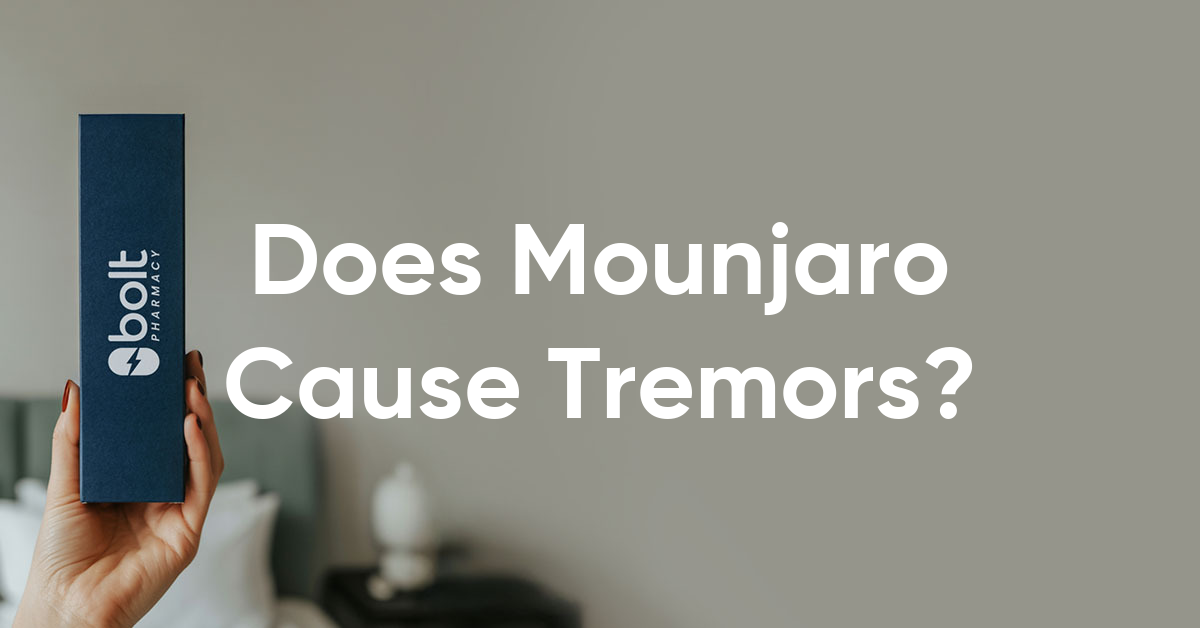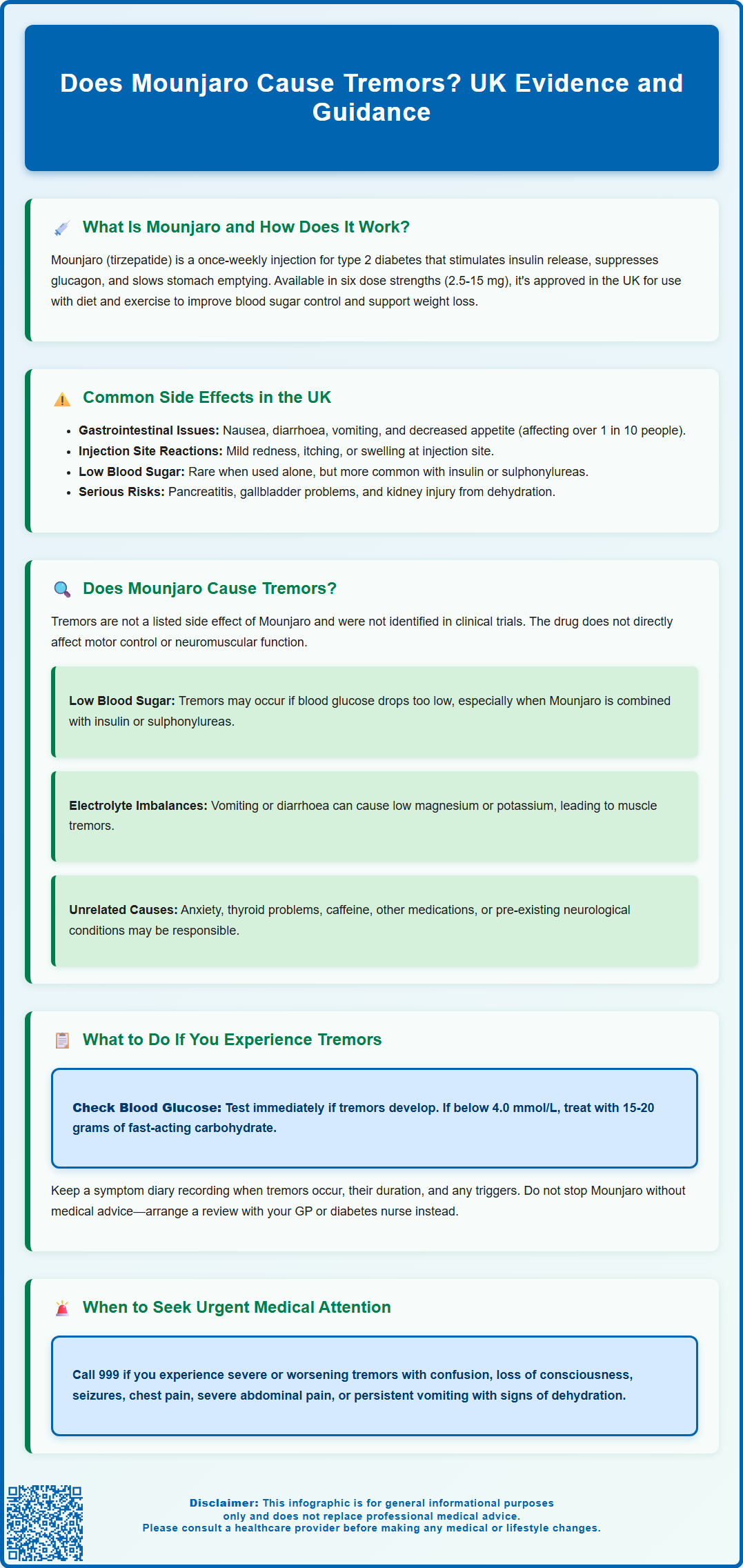Mounjaro®
Dual-agonist support that helps curb appetite, hunger, and cravings to drive substantial, sustained weight loss.
- ~22.5% average body weight loss
- Significant weight reduction
- Improves blood sugar levels
- Clinically proven weight loss

Mounjaro (tirzepatide) is a once-weekly injectable medicine licensed in the UK for treating type 2 diabetes in adults. As a dual GIP and GLP-1 receptor agonist, it helps control blood sugar levels and can lead to weight loss. Whilst Mounjaro is generally well tolerated, patients may experience side effects—most commonly gastrointestinal symptoms such as nausea and diarrhoea. Some individuals have raised concerns about whether Mounjaro causes tremors. This article examines the evidence, explores possible explanations for tremor-like symptoms, and provides practical guidance on what to do if you experience tremors whilst taking this medication.
Summary: Tremors are not listed as a recognised side effect of Mounjaro (tirzepatide) in UK prescribing information or clinical trials.
Mounjaro (tirzepatide) is a prescription medicine licensed in the UK for the treatment of type 2 diabetes mellitus in adults. It is administered as a once-weekly subcutaneous injection and belongs to a class of medications that act as dual glucose-dependent insulinotropic polypeptide (GIP) and glucagon-like peptide-1 (GLP-1) receptor agonists.
The pharmacological action of tirzepatide centres on enhancing the body's natural incretin response. When blood glucose levels rise after eating, Mounjaro stimulates insulin secretion from pancreatic beta cells in a glucose-dependent manner, meaning insulin is only released when needed. Simultaneously, it suppresses the release of glucagon—a hormone that raises blood sugar—thereby reducing hepatic glucose production. This dual action helps to maintain more stable blood glucose levels throughout the day.
Beyond glycaemic control, Mounjaro also slows gastric emptying, particularly after initiation and dose increases, which prolongs the feeling of fullness after meals and can contribute to weight loss. This effect is transient and may affect the absorption of some oral medicines. Mounjaro also acts on appetite-regulating centres in the brain, reducing hunger and caloric intake. Clinical trials have demonstrated significant reductions in HbA1c (a marker of long-term blood sugar control) and body weight in patients treated with tirzepatide.
In the UK, Mounjaro is available in several dose strengths (2.5 mg, 5 mg, 7.5 mg, 10 mg, 12.5 mg, and 15 mg) to allow for gradual dose escalation. This titration schedule helps to minimise gastrointestinal side effects and improve tolerability. The Medicines and Healthcare products Regulatory Agency (MHRA) has approved Mounjaro for use alongside diet and exercise, as monotherapy when metformin is not appropriate (due to intolerance or contraindications), or in combination with other glucose-lowering medications when glycaemic targets are not achieved with existing treatment.
Women using oral contraceptives should be advised to use an additional contraceptive method for 4 weeks after starting Mounjaro and for 4 weeks after each dose increase, as the delayed gastric emptying may affect contraceptive efficacy.

As with all medications, Mounjaro can cause side effects, although not everyone will experience them. The most frequently reported adverse effects are gastrointestinal in nature, reflecting the drug's mechanism of slowing gastric emptying and its action on the digestive system. Understanding these common reactions can help patients and healthcare professionals anticipate and manage them effectively.
Very common side effects (affecting more than 1 in 10 people) include:
Nausea – particularly during the initial weeks of treatment or following dose increases
Diarrhoea – loose or frequent bowel movements
Decreased appetite – often considered a therapeutic effect but can be troublesome for some
Common side effects (affecting up to 1 in 10 people) include:
Vomiting – which may occur alongside nausea
Constipation – affecting some individuals, particularly with higher doses
Abdominal discomfort or pain – ranging from mild bloating to cramping
Dyspepsia (indigestion) – a sensation of fullness or discomfort in the upper abdomen
Beyond the digestive system, patients may experience injection site reactions such as redness, itching, or swelling where the medication is administered. These are typically mild and resolve without intervention. Fatigue and dizziness have also been reported, though less commonly.
It is important to note that hypoglycaemia (low blood sugar) is uncommon when Mounjaro is used alone but can occur more frequently when used in combination with insulin or sulfonylureas. Symptoms of hypoglycaemia include trembling, sweating, confusion, palpitations, and hunger. Patients should be educated on recognising and managing low blood sugar episodes.
More serious but less common adverse effects include:
Pancreatitis (inflammation of the pancreas), which presents with severe, persistent abdominal pain that may radiate to the back
Gallbladder disorders including gallstones and inflammation of the gallbladder, which may cause right upper abdominal pain, fever, or jaundice
Acute kidney injury secondary to dehydration from persistent vomiting or diarrhoea, which may present with reduced urine output
Any patient experiencing such symptoms should seek urgent medical attention. The MHRA continues to monitor the safety profile of tirzepatide through pharmacovigilance programmes. Patients and healthcare professionals are encouraged to report any suspected adverse reactions via the Yellow Card Scheme (yellowcard.mhra.gov.uk).
Tremors are not listed as an adverse reaction of Mounjaro in the UK Summary of Product Characteristics (SmPC) and are not mechanistically expected based on how tirzepatide works. Clinical trials involving thousands of participants did not identify tremor as a frequent adverse reaction directly attributable to tirzepatide. However, it is important to consider the broader clinical context when a patient reports tremors while taking this medication.
Tremors—involuntary, rhythmic shaking movements—can arise from a variety of causes. The drug primarily affects incretin pathways, gastric motility, and appetite regulation, none of which are directly associated with motor control or neuromuscular function. That said, indirect factors related to Mounjaro use may contribute to tremor-like symptoms in certain individuals.
One plausible explanation is hypoglycaemia (low blood sugar), particularly in patients taking Mounjaro alongside other glucose-lowering agents such as insulin or sulfonylureas. Hypoglycaemia commonly presents with tremor, sweating, palpitations, confusion, and hunger. If blood glucose drops too low, the body releases adrenaline as a counter-regulatory response, which can cause shaking. Patients experiencing tremors should check their blood glucose levels promptly to rule out hypoglycaemia.
Another consideration is electrolyte imbalance secondary to gastrointestinal side effects. Persistent vomiting or diarrhoea—both common with Mounjaro—can lead to dehydration and disturbances in sodium, potassium, or magnesium levels. Electrolyte abnormalities, particularly hypomagnesaemia or hypokalaemia, can manifest as muscle tremors, weakness, or cramps.
Additionally, anxiety or stress related to starting a new medication, concerns about side effects, or the psychological impact of managing a chronic condition like diabetes may contribute to tremor. Other common causes of tremor include thyroid dysfunction (particularly hyperthyroidism), stimulants or caffeine consumption, use of beta-agonist inhalers, alcohol withdrawal, and medication-induced tremors from other drugs.
Pre-existing conditions such as essential tremor, Parkinson's disease, or other neurological conditions should also be considered in the differential diagnosis.
It is essential that any patient experiencing new or worsening tremors while taking Mounjaro discusses this symptom with their GP or diabetes specialist. A thorough clinical assessment, including blood glucose monitoring, electrolyte panels, thyroid function tests, and review of concurrent medications, can help identify the underlying cause and guide appropriate management.
If you develop tremors after starting Mounjaro, it is important to take a systematic approach to identify the cause and ensure your safety. Do not stop taking your medication without consulting your healthcare provider, as abrupt discontinuation may affect your diabetes control. Instead, follow these practical steps:
1. Check your blood glucose levels immediately. Tremor is a hallmark symptom of hypoglycaemia. If your blood sugar is below 4.0 mmol/L, treat it promptly with 15–20 grams of fast-acting carbohydrate (e.g., glucose tablets, a small glass of fruit juice, or sugary sweets). Recheck your blood glucose after 15 minutes and repeat treatment if necessary. Once your blood glucose is above 4.0 mmol/L and you feel better, eat a longer-acting carbohydrate snack or your next meal if it's due soon. Do not drive during or after a hypoglycaemic episode until you have fully recovered and follow DVLA guidance on diabetes and driving.
2. Monitor for other symptoms. Note whether the tremor is accompanied by sweating, palpitations, dizziness, nausea, vomiting, diarrhoea, or muscle weakness. These additional symptoms can provide important clues. For example, persistent gastrointestinal symptoms may suggest dehydration or electrolyte disturbance, while palpitations and sweating may point towards hypoglycaemia or anxiety.
3. Keep a symptom diary. Record when the tremors occur, their duration, severity, and any potential triggers (e.g., after meals, during physical activity, or at specific times of day). This information will be valuable when discussing your symptoms with your GP or diabetes specialist.
4. Contact your GP or diabetes nurse. Arrange a review appointment to discuss your symptoms. Your healthcare provider may:
Perform a physical examination and take a detailed medical history
Order blood tests to check electrolytes, kidney function, thyroid function, and HbA1c
Review your current medications for potential drug interactions or side effects
Assess whether dose adjustment or alternative diabetes treatment is appropriate
5. Seek urgent medical attention if:
Tremors are severe, persistent, or worsening
You experience confusion, loss of consciousness, or seizures (possible severe hypoglycaemia) – call 999 and use glucagon if available and you have been trained to use it
You have chest pain, severe palpitations, or difficulty breathing
You develop severe abdominal pain (possible pancreatitis)
You have persistent vomiting or diarrhoea with signs of dehydration (reduced urine output, extreme thirst, dizziness when standing)
You develop right upper abdominal pain with fever or yellowing of the skin/eyes (possible gallbladder problems)
For urgent concerns that aren't life-threatening, contact NHS 111 for advice. For life-threatening symptoms, call 999.
In line with NICE guidance on diabetes management, regular monitoring and open communication with your healthcare team are essential for safe and effective treatment. If tremors are confirmed to be related to Mounjaro, your clinician may consider dose modification, additional supportive measures, or switching to an alternative glucose-lowering therapy.
If you suspect your tremors might be a side effect of Mounjaro, you can report this through the MHRA Yellow Card Scheme at yellowcard.mhra.gov.uk or ask your healthcare professional to do so on your behalf.
No, tremors are not listed as an adverse reaction in the UK Summary of Product Characteristics for Mounjaro (tirzepatide), nor were they identified as a frequent side effect in clinical trials. However, tremors may occur indirectly due to hypoglycaemia or electrolyte imbalances related to treatment.
Check your blood glucose immediately, as tremor is a common symptom of hypoglycaemia. If blood sugar is below 4.0 mmol/L, treat with fast-acting carbohydrate. Contact your GP or diabetes nurse to discuss your symptoms and arrange a clinical review to identify the underlying cause.
Yes, hypoglycaemia can cause tremor, sweating, and palpitations. Whilst Mounjaro alone rarely causes low blood sugar, the risk increases when used with insulin or sulfonylureas. Patients should monitor blood glucose regularly and recognise early warning signs of hypoglycaemia.
The health-related content published on this site is based on credible scientific sources and is periodically reviewed to ensure accuracy and relevance. Although we aim to reflect the most current medical knowledge, the material is meant for general education and awareness only.
The information on this site is not a substitute for professional medical advice. For any health concerns, please speak with a qualified medical professional. By using this information, you acknowledge responsibility for any decisions made and understand we are not liable for any consequences that may result.
Lorem ipsum dolor sit amet, consectetur adipiscing elit, sed do eiusmod tempor incididunt ut labore et dolore magna aliqua. Ut enim ad minim veniam, quis nostrud exercitation ullamco laboris nisi ut aliquip ex ea commodo consequat. Duis aute irure dolor in reprehenderit in voluptate velit esse cillum dolore eu fugiat nulla pariatur.
Block quote
Ordered list
Unordered list
Bold text
Emphasis
Superscript
Subscript